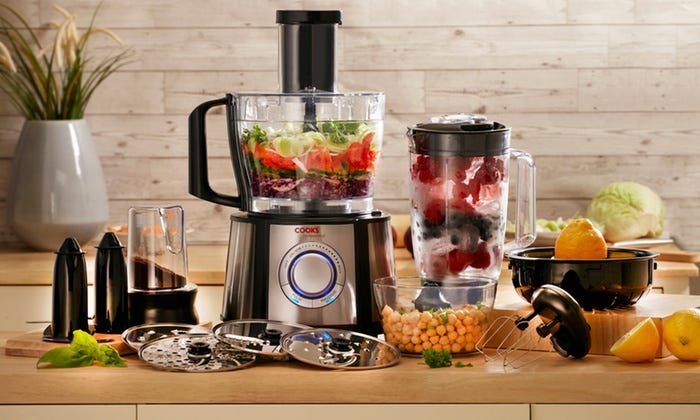People commonly view the food processor as a kitchen appliance designed for assistance.
The primary advantage of this appliance is that it saves time.
Although a food processor reduces your time in the kitchen, research indicates it potentially poses a risk to your health.
What Are Some Of The Risks Involved In Using A Food Processor?
1: Hidden Chemical Migration
The majority of food processors rely on plastic elements for their construction.
The components used for making food processor bowls and lids along with the blade segments consist of polycarbonate or polypropylene plastic materials.
Plastic materials that contain BPA (bisphenol A) or phthalates tend to release chemicals into food during heating or the introduction of acidic substances.
Why This Matters
People generally operate food processors on food ingredients, including fresh vegetables and cooked pasta.
BPA-free labels on storage containers do not provide any guarantee the contents are safe for consumption.
The chemical alternative to BPA called BPS proves to be equally dangerous to human health.
The substances migrate from plastic containers to food and can trigger hormonal disruptions and affect metabolic functions while potentially raising the possibility of breast and prostate cancer emergence.
2: Over processing and nutrient loss
A thorough processing lowers fibrous content and essential minerals and plant elements from some foods, such as fruits, vegetables, and grains.
Upon liquefying vegetables, their antioxidant content declines. Potato strands that have been ground get brittle to keep and metabolize rapidly.
For the human body to maintain blood sugar wellness and healthy digestive systems, fiber is necessary.
The body needs carotenoids to perform cell repair processes and control fibrosis.
The rapid digestion of food due to extreme deterioration before ingestion raises blood sugar levels and makes you feel hungry again sooner than you otherwise would have.
3: Cross-Contamination
When you put raw chicken into your food processor, did you follow it with vegetable chopping before performing a complete wash of the machine? Cross-contamination occurs more frequently than most people anticipate.
Food processors contain numerous nooks and crannies with small components, rendering their cleanup a significant challenge.
Unclean food processors become reservoirs for dangerous microorganisms such as Salmonella, Listeria, and E. coli.
Why This Matters
Foodborne illnesses mainly develop from contaminated food items.
The dual use of food processors between raw and cooked ingredients creates a double risk of contamination.
Bacteria can hide in unreachable areas that allow them to spread contamination to new food products over multiple days.
4: Microplastic Shedding
This one’s newer—and more alarming.
Analysis shows that the high-speed movements of bladed utensils result in plastic bowls and lids releasing microscopic plastic fragments.
The tiny fragments make their way into your food during processing.
Research shows that microplastics exist in human blood along with organs and breast milk.
Why This Matters
The effects of eating microplastic particles continue to remain under scientific investigation.
Research conducted thus far indicates potential relationships between plastic contamination and inflammation, together with immune system problems and cancer development.
Food processors may contribute small but frequent microplastic particles to your diet.
5: Encourages Processed Eating Habits
Whilst processors can facilitate the tedious task of preparing food, they also promote shortcuts, which is ambivalent.
Besides thick dough batters, which frequently include a lot of fat, sugar, and salt, the food processor allows users to create delicious dips and sauces.
It is widely acknowledged that a food processor reduces the process of making queso, cookie dough, and creamy sauces.
Many individuals are unaware that they are eating more processed foods at home.
Something could still be lacking in nutrition even if it is homemade.
If you use the food processor a lot, you might prefer processed meals over whole foods because they need less preparation.
6: Metal Blade Contamination
Tiny pieces of metal can contaminate your food while it is being processed due to dull blades in food processors and inadequate machining.
This problem is more common in older and less expensive devices. The equipment’s edges corrode, and metal fatigue causes the blades to progressively deteriorate.
Eating metal fragments puts your health at considerable danger for two reasons: as a toxin that damages your digestive system and as a long-term accumulation of heavy metals in your body.
Unnoticed health hazards are created by the contaminated chemicals’ invisibility to the human sight.
Your Next Step: Rethink the Role of Your Food Processor
There is no need to abandon your food processor for daily use. By understanding the potential risks, you can now choose wiser food processing methods.
Through proper cleaning methods each time you finish using it.
Any hot or acidic foods should never get processed inside plastic bowls.
Limit over processing to preserve nutrients.
When selecting a new food processor, choose glass or stainless steel materials instead of plastic models.
Always stay aware of what you prepare and why you prepare it.
Make certain your kitchen space exclusively serves as a nutritious place rather than a space damaging your health.
As a personal challenge during this week, try preparing all your meals without using any appliances.
No machines. Just your hands, a knife, and some raw ingredients. See how it feels. Taste the difference.
Frequently Asked Questions
1. Do food processors create allergic reactions?
A food processor may lead to allergies when it fails to receive proper cleaning operations. Food particles from previous use can blend with fresh ingredients that may lead to allergic reactions in users.
2. Is it safe for children to operate food processors?
Not without supervision. The blades maintain their sharpness, yet the lids require careful handling. Always monitor use.
3. Is it safe to operate a food processor when preparing hot foods?
It’s not recommended. Extended exposure to heat forces plastic components to emit harmful chemicals into food while creating permanent deformation of the food processor container.
4. Is frequent daily use of a food processor safe for consumption?
The repetitive daily use of a food processor leads to increased wear on the equipment, thus raising the risk of contaminated particles from plastic or metal elements.
5. Can handling my food with the processor cause problems with digestion?
Yes. The absence of dietary fiber in overprocessed meals causes blood sugar fluctuations and reduces both digestion and satisfaction.
6. Does a food processor strip enzymes away from raw foods through its cutting operations?
Rapid and forceful cutting with high speed has the potential to create heat sufficient enough to diminish enzyme functioning in uncooked vegetables or fruits.
7. Does using a food processor with a glass container provide better safety than one made from plastic?
Generally, yes. Glass material provides prolonged usage safety because it maintains chemical integrity and minimizes its release of plastic microparticles.
Final Thoughts
You do not have to discard your food processor today because of any of this.
But awareness is vital. It is a tool that may be utilized effectively or improperly.
Fear is not the reason for the above-mentioned concealed health dangers. Making educated decisions is the focus.
Recognizing the hazards allows you to take precautions, such as reducing high-speed processing of hot or acidic meals, rinsing thoroughly, and using glass bowls wherever feasible.



Awesome https://t.ly/tndaA